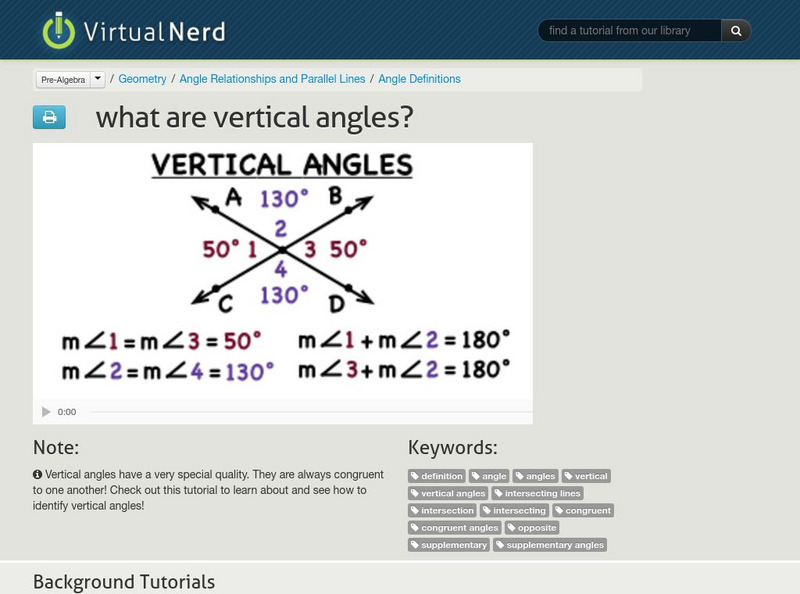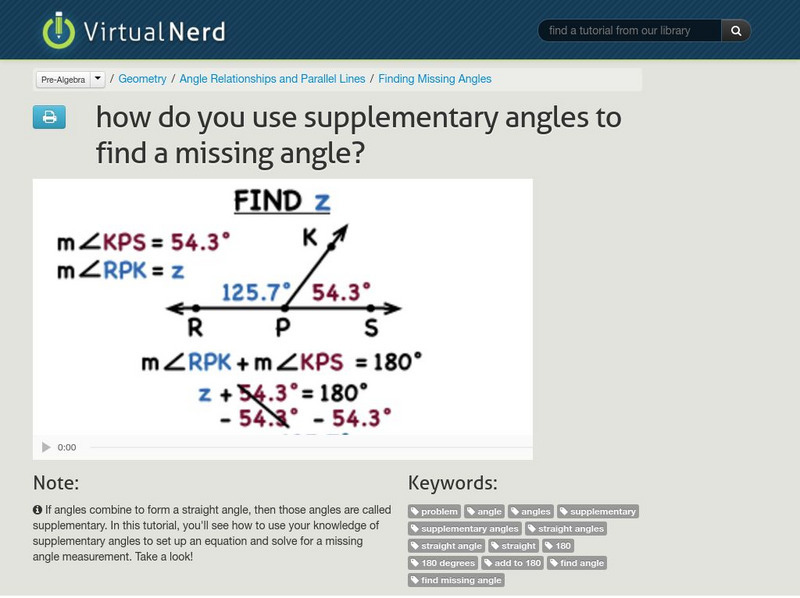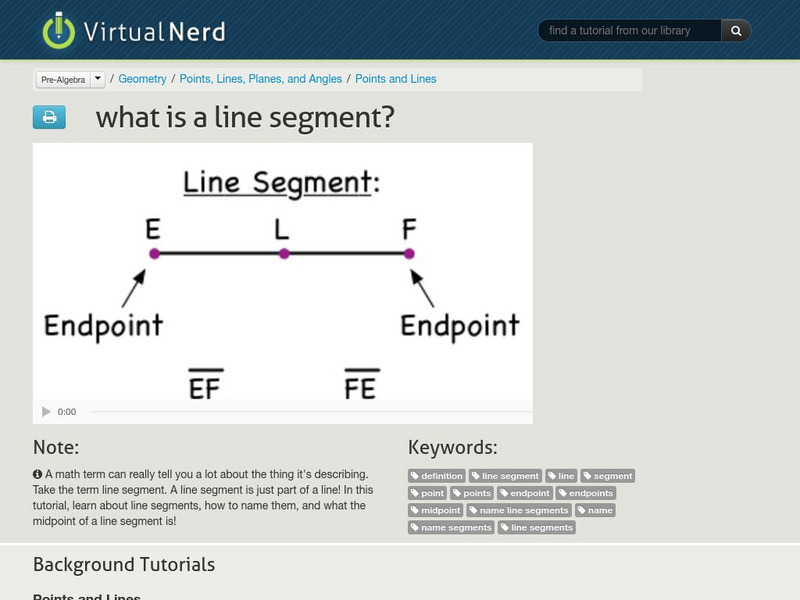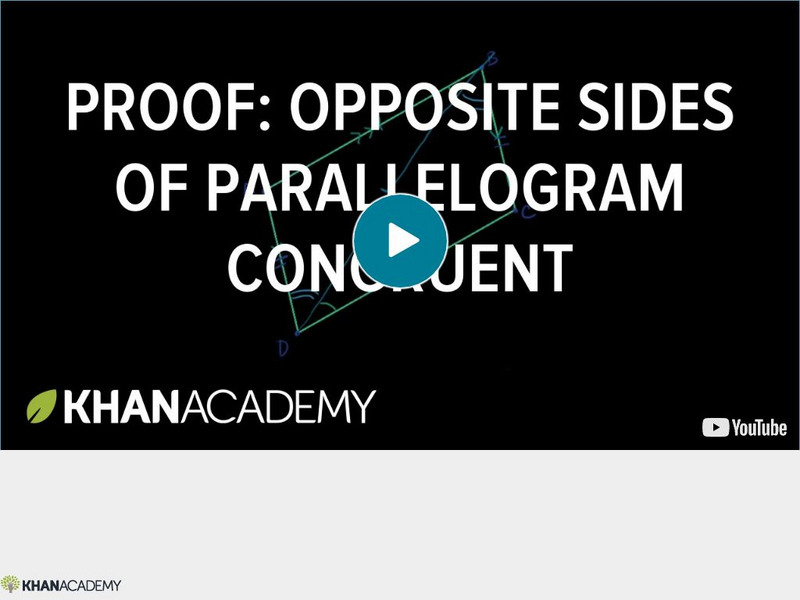Hi, what do you want to do?
Virtual Nerd
Virtual Nerd: What Are Skew Lines?
This video tutorial introduces skew lines which are two lines that do not intersect and are not parallel. [3:46]
Khan Academy
Khan Academy: Parallel and Perpendicular Lines
Demonstrates how to identify parallel and perpendicular lines in geometric drawings. [3:34]
Virtual Nerd
Virtual Nerd: How Do You Find Missing Angles in a Transversal Diagram?
Take a look at this tutorial to see how to find all the missing angle measurements by identifying vertical, corresponding, adjacent, and alternate exterior angles. [4:43]
Virtual Nerd
Virtual Nerd: What Are Vertical Angles?
Vertical angles are always congruent to one another. Take a look at this tutorial to learn about and see how to identify vertical angles. [4:07]
Virtual Nerd
Virtual Nerd: What Are Complementary Angles?
Complementary angles always add up to 90 degrees. Watch this tutorial to learn about complementary angles and see how to use this knowledge to solve a problem involving these special types of angles. [3:20]
Virtual Nerd
Virtual Nerd: How Do You Use Supplementary Angles to Find a Missing Angle?
In this tutorial, you'll see how to use your knowledge of supplementary angles to set up an equation and solve for a missing angle measurement. [3:41]
Virtual Nerd
Virtual Nerd: What Are Supplementary Angles?
Take a look at this tutorial as it introduces you to supplementary angles and shows you how to use them to solve for a missing angle measurement. [3:20]
PBS
Pbs: Measurement and Geometry: Angles: Vertical and Congruent
Vertical angles lie diagonally opposite one another at an intersection and are always equal in measure. This makes them congruent.
Virtual Nerd
Virtual Nerd: What Is a Point?
Points are needed to make lines, planes, angles, or polygons. and also for graphing. Watch this tutorial to learn about points. [3:50]
Khan Academy
Khan Academy: Geometry: Triangle Angle Example 2
Shows how to find the measure of missing angles using the triangle sum theorem and vertical angles. This video also appears in the Geometry: Triangles strand. [4:55]
Khan Academy
Khan Academy: Geometry: Angles (Part 3)
Identifies and defines the types of angles formed by parallel lines cut by a transversal and the relationship of their measures. Discusses Triangle Sum Theorem. [9:48]
Khan Academy
Khan Academy: Geometry: Ca Geometry: Pythagorean Theorem, Compass Constructions
This video tutorial demonstrates solutions to problems #51-55 of the California Geometry released state test questions. Problems address proving and using the Pythagorean theorem and compass constructions. [12:35]
Khan Academy
Khan Academy: Geometry: Angles Formed Between Transversals and Parallel Lines
Explains the relationship between the measures of angles formed when parallel lines are cut by a transversal based on relationships of corresponding, vertical, and supplementary angles. [7:53]
Virtual Nerd
Virtual Nerd: What Is a Line Segment?
Take a look at this tutorial to learn about line segments, how to name them, and what the midpoint of a line segment is. [3:13]
Khan Academy
Khan Academy: Geometry: Similar Example Problems
Explains how to identify and use similar triangles in order to determine unknown side lengths in two given diagrams. Each diagram also applies knowledge of angles formed when parallel lines are cut by a transversal. [7:37]
Khan Academy
Khan Academy: Geometry: Proof: Opposite Sides of Parallelogram Congruent
Demonstrates how to prove that the opposite sides of a parallelogram are congruent based on knowledge of the special angles created when parallel lines are cut by a transversal and the triangle congruency postulates. [8:30]
Khan Academy
Khan Academy: Geometry: Proof: Diagonals of Parallelogram Bisect Each Other
Demonstrates how to prove that the diagonals of a parallelogram bisect each other based on knowledge of the special angles created when parallel lines are cut by a transversal and the triangle congruency postulates. [9:06]
PBS
Pbs Learning Media: Real Life Math: Woodworker
Listen to a master craftsman explain many of the ways that mathematics is used in woodworking, including number operations; geometry; ratios and proportions; and measurement. In the accompanying activity, students will draw a scale...
Virtual Nerd
Virtual Nerd: What Is a Ray?
Rays are very useful as two rays can create an angle, multiple angles can create a polygon, and by adding another dimension you get three-dimensional solids. This tutorial introduces you to rays and shows you how to name them. [4:51]
Virtual Nerd
Virtual Nerd: What Is a Degree?
Watch this tutorial to learn what a degree is and how it relates to a circle. [3:08]
Virtual Nerd
Virtual Nerd: What Is a Plane?
This tutorial introduces planes and shows how to name them. [3:44]
Virtual Nerd
Virtual Nerd: What Is a Transversal?
This tutorial introduces transversals and shows what happens when a transversal meets two parallel lines. [6 :22]

























